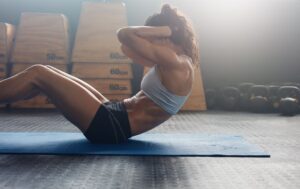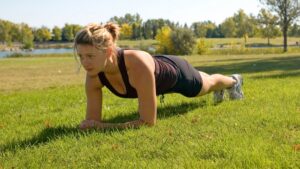The abdominal strap is an area that all athletes and fitness enthusiasts seek to have a flat stomach and protruding abs. But we're not going to lie: a "six-pack" is not forged in a day. Many people spend half of their weight training sessions working their abs without getting any results. However, it is quite possible to strengthen this upper part of the body by performing weight training exercises that target the abdominal muscles, in addition to cardio sessions and a healthy diet. Overview on the best exercises to have well-drawn abs.
Au sommaire
ToggleWarm-up: squat exercises
At the beginning of the session, squats are essential as a warm-up to solicit the muscles of the lower body and those of the trunk, it is a good sports training. To perform squats, simply place the feet hip-width and then lower the buttocks to the ground. Then cross your arms down (hands to the ground, near the knees) to involve the abdominal muscles. When you return upwards, it is then advisable to raise the arms above the head in the V position. The ideal would be to finish 3 sets of 15 squats in order to prepare the body for the training of the abs.
The crunch for the abs

Anyway, the crunch has the particularity of being suitable for beginners, since it does not carry any major risks. The principle is simple: you lie down and put your back on the ground. The legs should rest on a chair and the arms should rest on the thighs. Once well positioned, you will slide your hands over your thighs until you reach the kneecap while flexing your bust. You practice the climb by exhaling slowly, then you descend to return to your starting posture. As you descend, inhale slowly.
Of course, we only mentioned at the top the basic movements of the crunch abs, and there are many variants of the crunch. Once you master the crunch abs, you can move to a higher level, such as the crunch without chair, the crunch legs raised without support, the crunch abs crossed, the double crunch as well as the crunch on gym ball. Finally, there is also another variant, the crunch with the high pulley, which allows to muscle the large right of the abdomen. To do this, you can help from your lumbar, which you need to unroll and roll up throughout the movements.
The basin survey
This exercise is often called, wrongly, "leg lift", when it involves mobilizing the pelvis in order to properly target the lower part of the abdominals. By raising the legs without taking care to tilt the pelvis forward, we put too much strain on the psoas and hip flexors while mobilizing the abdominals, which can lead to pain in the lumbar area, the relaxation of the transverse or the elongation of the large right of the abdomen. Hence the interest of winding the pelvis well during this exercise.
To make a basin survey, hang from a fixed bar and wind the basin forward. At the time of your descent, your lumbar will help you to strengthen the eccentric phase and avoid swaying.
If you use a Roman chair, use its backrest to secure your lumbar while keeping your legs bent and the pelvis curled. During the eccentric phase, do not go down to the bottom but rather so that your knees are perpendicular to the ground. In addition, on a flat or inclined bench, the pelvis survey makes it possible to solicit the lower part of the abs without putting pressure on the lower back.
The board
If the board seduces so many bodybuilding enthusiasts, it is because it offers the desired result. Thanks to the board, you work not only your abs but also your back. However, if the practice of the board seems easy at first glance, it still requires considerable effort.
To make the perfect board, you lie on your stomach and put your forearms on the ground. Make sure that, throughout the movements, your elbows are aligned with the shoulders and that your toes are rested on the floor. Then, focus by attaching a point to the ground between your hands, in order to also keep the neck and spine straight. Then lift your body while leaning on your forearms and toes. Keep this position for at least 20 seconds before resting the body flat and then repeat the effort at least 6 times.
Exercise of abs at TRX
Since its invention, trx has seduced many bodybuilders who want to work at body weight with instability. Thanks to a system of straps that distributes the weight of the body on the muscles, it allows you to build muscle quickly and in any place. But TRX has the advantage of being particularly suitable for abdominal exercises, because it solicits both the superficial muscles and the transverse abdominal muscle. The practice of TRX for abs is therefore an effective and practical way to strengthen your abs while maximizing sheathing.
To do this, place yourself on a board by leaning on the palms of your hands, with your feet stuck in the straps of the equipment. Then bring your knees back to the bust and then return to the starting position.
Sheathing exercises

Classic sheathing
We have already talked about the classic sheathing, also called "board exercise", a series of movements to strengthen the deep muscles of the abdomen. Admittedly, the classic sheathing does not act directly on the abs, but it nevertheless makes it possible to obtain a flat stomach and contributes to the improvement of postures when performing many bodybuilding exercises.
The sheathing of the obliques
The sheathing of the obliques, or "side bridge" is also essential to work on your abs and, in particular, your obliques. Indeed, this series of movements makes it possible to strengthen all the muscles that are located around the spine. Enough to actively fight against back pain!
To perform this sheathing exercise, follow these steps: stand on the floor, sideways. Then put a forearm on the floor and use it to lift your body weight. Keep your forearm straight for a few seconds then release and change sides. You can make this exercise more dynamic in order to strengthen the obliques. For this, add a series of descents and ascents of the hips during the sheathing.
See other articles on sports training to lose weight:
